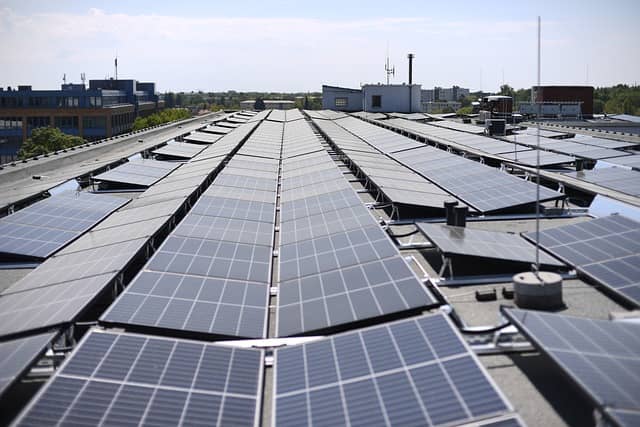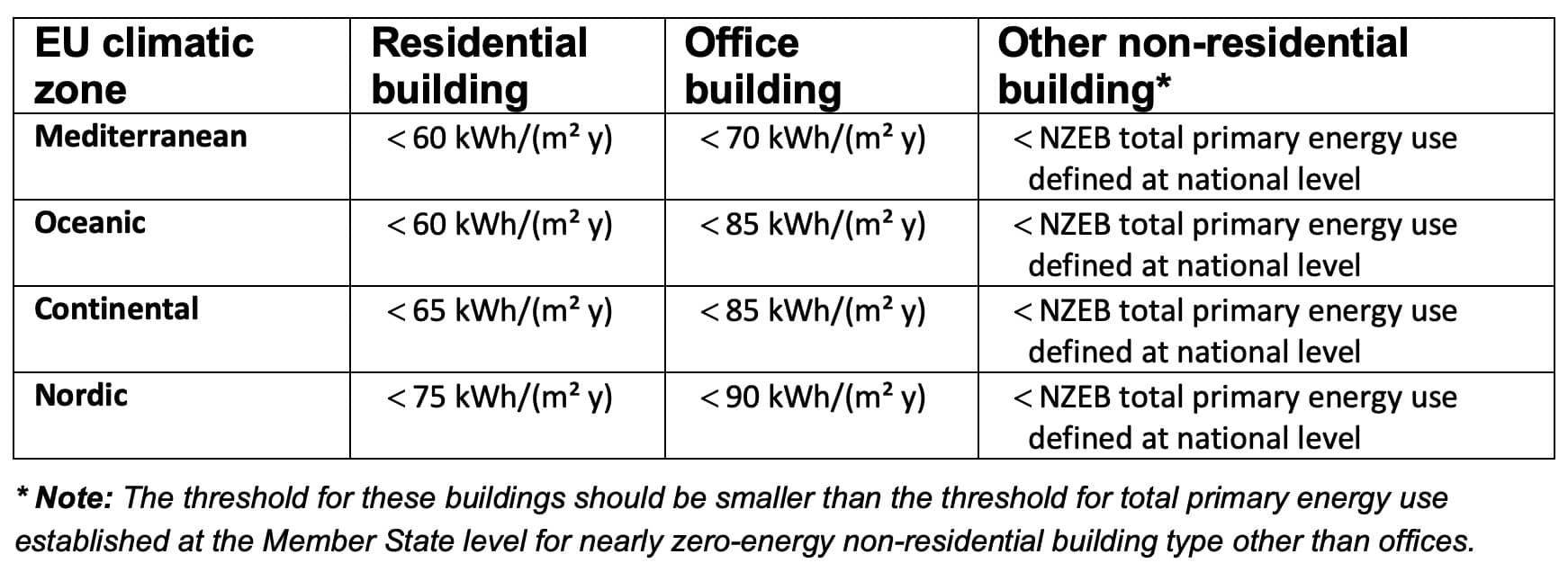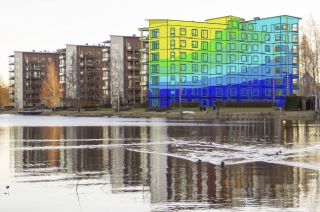
www.buildingsandcities.org/insights/commentaries/zero-carbon-buildings.html
Transitioning to Zero-Carbon Buildings

What is needed to make today's buildings zero-carbon ready?
The urgency to radically reduce primary energy consumption and greenhouse gas (GHG) emissions during the life cycle of buildings is undisputed. The ultimate goal is a building stock which does not rely upon GHG emissions and compensates for any remaining emissions using effective and acknowledged measures (Lützkendorf & Frischknecht 2020). Thomas Lützkendorf (Karlsruhe Institute of Technology) and Rolf Frischknecht (Treeze Ltd) explore the implications for making buildings now that are zero-carbon-ready.
A low carbon building stock implies the creation of adaptable long-life buildings made with biogenic and low-carbon construction products, and with low operational energy demand, efficient technologies and a renewable, low-carbon energy source.
To achieve this necessitates enlarging the scope of assessment beyond the operational phase to include the whole life cycle of buildings (e.g. manufacture, construction, operation, maintenance, refurbishment and end of life).
Challenges
Two important challenges arise:
- How to transition from the present situation to a net-zero emissions building stock by 2050 (or preferably before 2040)? For buildings which are erected or refurbished today what affordances can be provided (without further changes to their fabric or equipment) to switch the energy supply system and / or provide renewable energy onsite now or at a later date without incurring further GHG emissions?
- What requirements are needed to avoid lock-in effects and create opportunities to reach net-zero or net-negative emissions buildings? (Such requirements include reducing energy demand, improving energy efficiency in the building and the design of the energy supply, the use and choice of renewable energy carriers.)
In doing so, requirements must also take into account the effect of climate change on the local climatic conditions, e.g. the growing cooling demand with consequence for operational and embodied GHG-emissions. When considering various strategies for creating a net-zero emissions building stock, several questions need to be addressed for new and retrofitted buildings:
- How can new buildings and refurbishments reach net-zero emissions in the construction phase (upfront embodied emissions), for maintenance, replacement and end of life (additional embodied emissions) as well as the operation phases?
- Is it feasible to reduce the operational energy demand and to change the energy supply of these buildings with little or no GHG emissions during the next refurbishment phase in the period of 2040-2050?
- Is it feasible to reduce the operational GHG emissions step-by-step using building technology due to the expected continuous increase of renewables leading to the decarbonisation of the energy supply?
- How and when will new buildings and refurbishments be able to reach a life-cycle based net zero emission level, covering construction, maintenance, operation and end of life?
Two approaches
Several concepts aim to reduce or eliminate GHG emissions caused by buildings. They differ in the definition of the scope and system boundary, in balancing or compensation measures, in whether and how technological progress is taken into account and in the terms used, such as 'zero carbon', 'net-zero emissions', 'CO2 neutral' or 'climate neutral'. Two recent strategies are considered:
- Proposal for a 'zero‐carbon‐ready building code' by IEA (International Energy Agency 2021a)
- Draft for next generation of Energy Performance Building Directive (EPBD) by European Commission (2021a).
The World Energy Outlook team and the Energy Technology Perspectives team of the International Energy Agency (IEA) introduced the new term 'zero-carbon ready' buildings in their roadmap for the global energy sector (International Energy Agency 2021a).The IEA defines a zero‐carbon-ready building as:
highly energy efficient and either uses renewable energy directly, or uses an energy supply that will be fully decarbonised by 2050, such as electricity or district heat. This means that a zero‐carbon‐ready building will become a zero‐carbon building by 2050, without any further changes to the building or its equipment. (International Energy Agency 2021, p. 144).
This approach covers operational energy supply, including stack emissions of power plants and heating plants. The 'zero-carbon-ready' approach describes therefore a continuous process towards the goal of a building's use phase with net zero emissions in scopes 1 and 2.1 It includes requirements to limit energy demand, and to meet this energy demand with renewable energies, either immediately or with a certain time lag. Figure 1 presents an illustration of the interpretation of the 'zero-carbon-ready' approach by the present authors.
![Figure 1: Interpretation of the IEA 'zero-carbon-ready' approach in the operation stage. [authors]](https://www.buildingsandcities.org/media/images/LutzFrischFig1v4lo.jpg)
The 'zero-carbon-ready' concept provides an answer to question 3 (above). It is likely that a decarbonised energy supply based on renewable resources is feasible and practicable by 2035 in Europe. The 'zero-carbon ready' approach can serve as a bridging solution for the operational part of GHG emissions.
We recommend that the requirements and limits on the energy demand during the use phase need to be determined individually on a country-by-country basis as it depends on specific conditions (e.g. their respective energy supply systems, the availability of renewable energies, their roadmap to net-zero GHG emissions, the existing building stock and local climatic conditions).
IEA recommends to take into account the possibilities of passive design features, building envelopeimprovements and high energy performance equipment. The IEA's 'zero-carbon-ready' concept includes embodied GHG emissions from the manufacturing of building construction materials and components (scope 3). Particularly, the following target and suggestions are formulated for their reduction:
Zero‐carbon‐ready building energy codes should also target net‐zero emissions from material use in buildings. Material efficiency strategies can cut cement and steel demand in the buildings sector by more than a third relative to baseline trends, and embodied emissions can be further reduced by more robust uptake of bio‐sourced and innovative construction materials. (International Energy Agency 2021, p. 144).
However, no clear guidelines exist for calculating and balancing GHG emissions over the life cycle in this IEA concept.

A similar approach is followed in the European Commission's draft EPBD dated 15.12.2021. There is no longer a requirement to reduce the energy demand of buildings to absolute zero. Instead, the operational energy demand is limited by the specification of thresholds. This energy demand should then be covered with renewable energy, which is preferably generated on the building site, or via district heating - see Table 1. The goal is a zero-emission level (scopes 1 and 2) in operation.
In addition, the draft EPBD proposes to mandate the calculation and reporting of GHG emissions over the whole life cycle for large new construction projects (e.g. floor area >2000 m²) from 2027 and for other construction projects (new buildings) from 2030. This information is intended to be included in future energy performance certificates. However,actual benchmarks or target values are not yet described. These proposals are roughly in line with those in the TAXONOMY of the European Commission (2020). In this context the following requirement is mentioned:
For buildings >5000 m2, the life-cycle Global Warming Potential (GWP) of the building resulting from the construction has been calculated for each stage in the life cycle and is disclosed to investors and clients on demand. (European Commission 2021c, p. 167)
Next steps
Both the IEA and draft EPBD can be understood as complementing each other. While the IEA describes the concept of a zero-ready building approach more comprehensibly, the draft EPBD already mentions possible requirements for limiting the energy demand. However, when it comes to dealing with emissions in the whole life cycle of the building under consideration, the ultimate consequence is missing. IEA aims for zero emissions for the embodied part but refrains from introducing requirements for life cycle assessment. The draft EPBD requires the calculation and reporting of life cycle assessment results based on life cycle assessment but does not establish any benchmarks, target values or performance scales.
Arguably, an obligation to calculate and declare the GHG emissions in the life cycle across the real estate market from 2030 comes too late and fails to create legally binding requirements. The Graz Declaration (Graz University of Technology 2019) and the Monte Verita Declaration (International Energy Agency 2021b) were signed by leading scientists from around the world. These declarations proposed the introduction of binding requirements to limit GHG emissions over the building life cycle starting in 2025. Work in this direction is already underway in several European countries, e.g. Finland, Denmark, Norway, Sweden (Danish Technological Institute 2021). In France legal binding requirements to limit GHG-emissions in the life cycle of buildings are already in place (Ministère de la Transition écologique 2020).
In conclusion, the IEA's concept of zero-carbon-ready buildings as well as the draft EPBD are useful but do not go not far enough. More ambitious goals are needed if the countries are to become net-zero by 2050. For example, what's needed is a binding and demanding target value for life-cycle-based GHG emissions of buildings (carbon footprint) by 2025 latest including a road map to net zero by 2035 for new and refurbished buildings (Monte Verità Declaration). Increased energy efficiency and renewable energy sources are the two key elements to reach net zero carbon buildings during operation. Low carbon materials must be developed and used in construction and refurbishment. Negative emission technologies will be needed to compensate for the remaining, unavoidable GHG emissions.
Methods to quantify and limit GHG emissions caused during the life cycle of buildings are under development in the IEA Annex 72 project Assessing Life Cycle Related Environmental Impacts Caused by Buildings, an international cooperation within the IEA Technology Cooperation Programme Energy in Buildings and Communities (EBC). Guidelines and recommendations are expected to be published in late 2022.2
Notes
1. The definitions of 'scopes' are mentioned in the Greenhouse Gas Protocol (WBCSD & WRI 2004). The IEA's interpretation of this is: Scope 1 = direct emissions from energy and other sources owned or controlled. Scope 2 = indirect emissions from the production of electricity and heat, and fuels purchased and used. Scope 3 = emissions from the manufacturing of building construction materials and components (embodied carbon emissions).
2. Visit https://annex72.iea-ebc.org/ for further information about the experts involved and for guidelines and recommendations.
References
Danish Technological Institute. (2021). Project on LCA and socioeconomics; Task 2 - Analysis of other countries' approach to building LCA.https://www.lifecyclecenter.se/wp-content/uploads/Analysis-of-other-countries-approach-to-building-LCA.pdf
International Energy Agency. (2021a). Net Zero by 2050 - a roadmap for the global energy sector. Revised version October 2021. https://iea.blob.core.windows.net/assets/deebef5d-0c34-4539-9d0c-10b13d840027/NetZeroby2050-ARoadmapfortheGlobalEnergySector_CORR.pdf
International Energy Agency. (2021b). Monte Verità Declaration on a built environment within planetary boundaries - Outcome of IEA EBC Annex 72. https://annex72.iea-ebc.org/Data/Sites/5/media/documents/monteverit%C3%A0declaration_final_signed.pdf
European Commission. (2020). Regulation (EU) 2020/852 of the European Parliament and of the Council of 18 June 2020 on the establishment of a framework to facilitate sustainable investment, and amending Regulation (EU) 2019/2088. Official Journal of the European Union, 2.6.2020 L 198/13. https://eur-lex.europa.eu/legal-content/EN/TXT/PDF/?uri=CELEX:32020R0852&from=EN
European Commission. (2021a).Proposal for a Directive of the European Parliament and of the Councilon the energy performance of buildings (recast). COM(2021) 802 final, 15.12.2021.https://ec.europa.eu/energy/sites/default/files/proposal-recast-energy-performance-buildings-directive.pdf
European Commission. (2021b). Annexes to the Proposal for a Directive of the European Parliament and of the Councilon the energy performance of buildings (recast). COM(2021) 802 final, 15.12.2021. https://ec.europa.eu/energy/sites/default/files/annex-proposal-recast-energy-performance-of-buildings-directive.pdf
European Commission. (2021c). Annex to the Commission Delegated Regulation (EU) supplementing Regulation (EU) 2020/852 of the European Parliament and of the Council by establishing the technical screening criteria for determining the conditions under which an economic activity qualifies as contributing substantially to climatechange mitigation or climate change adaptation and for determining whether thateconomic activity causes no significant harm to any of the other environmental objectives. C(2021) 2800 final, 4.6.2021. https://eur-lex.europa.eu/resource.html?uri=cellar:d84ec73c-c773-11eb-a925-01aa75ed71a1.0021.02/DOC_2&format=PDF
Lützkendorf T. & Frischknecht R. (2020). (Net-) zero-emission buildings: a typology of terms and definitions. Buildings and Cities, 1(1), 662-675. http://doi.org/10.5334/bc.66
Ministère de la Transition écologique. (2020). Réglementation Environnementale des Bâtiments Neufs (RE2020).http://www.rt-batiment.fr/IMG/pdf/guide_re2020_dhup-cerema.pdf
Graz University of Technology. (2019). Graz Declaration for Climate Protection in the Built Environment - Outcome of SBE19. https://www.tugraz.at/fileadmin/user_upload/tugrazExternal/570da940-43c8-4fcc-98c3-01b8c77c6316/Graz_Declaration_EN.pdf
WBCSD & WRI. (2004). The Greenhouse Gas Protocol - a corporate accounting and reporting standard. https://ghgprotocol.org/sites/default/files/standards/ghg-protocol-revised.pdf
Latest Peer-Reviewed Journal Content
Youth engagement in urban living labs: tools, methods and pedagogies
N Charalambous, C Panayi, C Mady, T Augustinčić & D Berc
Co-creating urban transformation: a stakeholder analysis for Germany’s heat transition
P Heger, C Bieber, M Hendawy & A Shooshtari
Placemaking living lab: creating resilient social and spatial infrastructures
M Dodd, N Madabhushi & R Lees
Church pipe organs: historical tuning records as indoor environmental evidence
B Bingley, A Knight & Y Xing
A framework for 1.5°C-aligned GHG budgets in architecture
G Betti, I Spaar, D Bachmann, A Jerosch-Herold, E Kühner, R Yang, K Avhad & S Sinning
Net zero retrofit of the building stock [editorial]
D Godoy-Shimizu & P Steadman
Co-learning in living labs: nurturing civic agency and resilience
A Belfield
The importance of multi-roles and code-switching in living labs
H Noller & A Tarik
Researchers’ shifting roles in living labs for knowledge co-production
C-C Dobre & G Faldi
Increasing civic resilience in urban living labs: city authorities’ roles
E Alatalo, M Laine & M Kyrönviita
Co-curation as civic practice in community engagement
Z Li, M Sunikka-Blank, R Purohit & F Samuel
Preserving buildings: emission reductions from circular economy strategies in Austria
N Alaux, V Kulmer, J Vogel & A Passer
Urban living labs: relationality between institutions and local circularity
P Palo, M Adelfio, J Lundin & E Brandão
Living labs: epistemic modelling, temporariness and land value
J Clossick, T Khonsari & U Steven
Co-creating interventions to prevent mosquito-borne disease transmission in hospitals
O Sloan Wood, E Lupenza, D M Agnello, J B Knudsen, M Msellem, K L Schiøler & F Saleh
Circularity at the neighbourhood scale: co-creative living lab lessons
J Honsa, A Versele, T Van de Kerckhove & C Piccardo
Positive energy districts and energy communities: how living labs create value
E Malakhatka, O Shafqat, A Sandoff & L Thuvander
Built environment governance and professionalism: the end of laissez-faire (again)
S Foxell
Co-creating justice in housing energy transitions through energy living labs
D Ricci, C Leiwakabessy, S van Wieringen, P de Koning & T Konstantinou
HVAC characterisation of existing Canadian buildings for decarbonisation retrofit identification
J Adebisi & J J McArthur
Simulation and the building performance gap [editorial]
M Donn
Developing criteria for effective building-sector commitments in nationally determined contributions
P Graham, K McFarlane & M Taheri
Join Our Community

The most important part of any journal is our people – readers, authors, reviewers, editorial board members and editors. You are cordially invited to join our community by joining our mailing list. We send out occasional emails about the journal – calls for papers, special issues, events and more.
We will not share your email with third parties. Read more



Latest Commentaries
COP30 Report
Matti Kuittinen (Aalto University) reflects on his experience of attending the 2025 UN Conference of the Parties in Belém, Brazil. The roadmaps and commitments failed to deliver the objectives of the 2025 Paris Agreement. However, 2 countries - Japan and Senegal - announced they are creating roadmaps to decarbonise their buildings. An international group of government ministers put housing on the agenda - specifying the need for reduced carbon and energy use along with affordability, quality and climate resilience.
Building-Related Research: New Context, New Challenges
Raymond J. Cole (University of British Columbia) reflects on the key challenges raised in the 34 commissioned essays for Buildings & Cities 5th anniversary. Not only are key research issues identified, but the consequences of changing contexts for conducting research and tailoring its influence on society are highlighted as key areas of action.